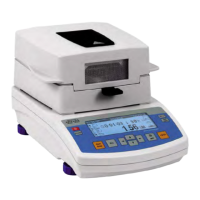13. SELECTION OF DRYING PARAMETERS
13.1. Selecting optimum sample mass
Sample mass influences the accuracy of measurement result and measurement time.
Higher mass of a sample, causes higher amount of water (moisture content) which needs to
evaporate, and therefore measurement time is also longer.
Obtaining short measurement time is feasible in case of small sample mass, but
sample mass cannot be too small, as it may negatively influence required measurement
accuracy.
13.2. Influence of sample mass on measurement result repeatability
Sample mass has considerable influence on repeatability of measurement results
obtained on a moisture analyzer. Relation between sample mass and repeatability is
presented in below table.
Data provided in the above table refer to a ideal and uniform sample, and an
assumption, that moisture content has completely evaporated from tested sample during
testing process, and the sample has not decomposed (e.g. humid high-silica sand).
Measurement results are always subject to uncertainty related to a sample and
repeatability of used moisture analyzer. In practice, it means that obtained measurement result
may exceed repeatability values provided above.
13.3. Drying temperature
Drying temperature has the largest impact on drying time. Temperature value depends
on type of dried substance. Too low drying temperature causes too low moisture content
evaporation (under-dried sample), and consequently unnecessary extending of measurement

